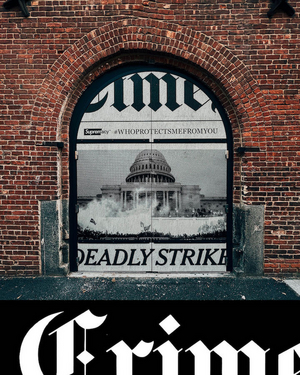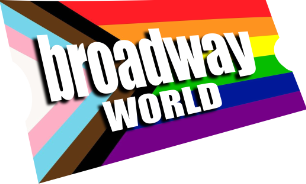St. Ann's Warehouse & Supremacy Project to Present New Public Art Exhibit
Supremacy Project introduces a new iteration of its series Supremacy: Who Protects Me from You?—considering January 6, 2021, a portrait of a broken system.

St. Ann's Warehouse and Supremacy Project, led by Julian Alexander and Khadijat Oseni, will present a new outdoor public art exhibition that goes to the heart of white supremacy, addressing "the systemic oppression and violence BIPOC communities are fighting to end through art." St. Ann's has, since George Floyd's murder, given over its exterior walls as an urban canvas for large-scale public art in urgent conversation with the moment. The organization now launches its second collaboration with Alexander and Oseni.
On the one-year anniversary of last year's Capitol insurrection, and at the beginning of an election year, Supremacy Project introduces a new iteration of its series Supremacy: Who Protects Me from You?-considering January 6, 2021, a disturbing portrait of one such broken system, and just another day in a long history of white supremacist violence.
Supremacy Project's first Who Protects Me from You? series focused on the U.S. government's executive branch (depicted as Mount Rushmore) and judicial branch (as riot police). The new installation, in the St. Ann's Warehouse archways on Dock Street, aims its lens on the legislative branch. The events at the Capitol are explosively captured by Mel D. Cole and Reuters photographer Leah Millis, and contextualized by artist Julian Alexander. A pointed redaction by Alexander-to a quote from Republican Senator Adam Kinzinger-underscores the notion that despite the insurrection's horror, it is but one of the countless "darkest days in American history" for non-white people.
Mel D. Cole explained to NBC News, when he showed up near the White House to document Trump's rally-in no way anticipating the traumatic events that would unfold-he found himself in "fear for [his] life" as a Black photographer in the core of that mob. He captured the events with frightening clarity and chilling closeness.
While insurrection plays out on Dock Street, We the People evokes the sublime on the Water Street facade of St. Ann's Warehouse, featuring images of transcendence by Lagos-based photographer Adeolu Osibodu and haikus by Cyrus Aaron, Mahogany L. Browne, and Justin El (each of whom contributed to Michael Boyd's Lost Ones. Culture Found exhibit from Supremacy Project last year). Curator Khadijat Oseni says, "We The People reexamines the American Constitution's exclusion of Black people with the Three-Fifths compromise. Through words and images conjuring ancestral memory, Black humanity is centered and presented as strong, vulnerable, whole. This juxtaposition sets off a meditation on the American myth."
Artist Julian Alexander anchors this sea of diasporic voices with a text-only piece of art: "ALWAYS BEEN 5/5 a ____.", serving as a meditative pause and update on the iconic "I AM A MAN" signage that has since become synonymous with the fight for social justice. Both the homage and style of Alexander's innovation reside in a similar framework as the genesis of the original slogan and sign which was first widely-made popular at the Memphis Sanitation strike of 1968, the last strike led by Dr. Martin Luther King Jr. days before his assassination.
The original sign's language comes from Ralph Ellison's Invisible Man. The full quote reads, "I am an invisible man. I am a man of substance, of flesh and bone, fibre and liquids - and I might even be said to possess a mind. I am invisible, understand, simply because people refuse to see me."
Julian Alexander's new signage picks up the baton from where the essential workers of the 1960s Civil rights movement left off by recontextualizing as well as leaving an open space at the end for active participation from on-lookers across all marginalized groups - regardless of culture, gender and sexuality, to aid in the collective reversion of America's promise.
St. Ann's Warehouse is located at 45 Water St. in DUMBO, Brooklyn.
Photo credit: Jose Cabaco
Comments
.png)
|
.png)
|
Videos
